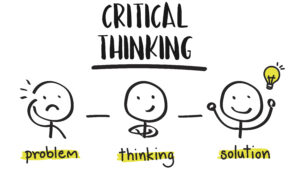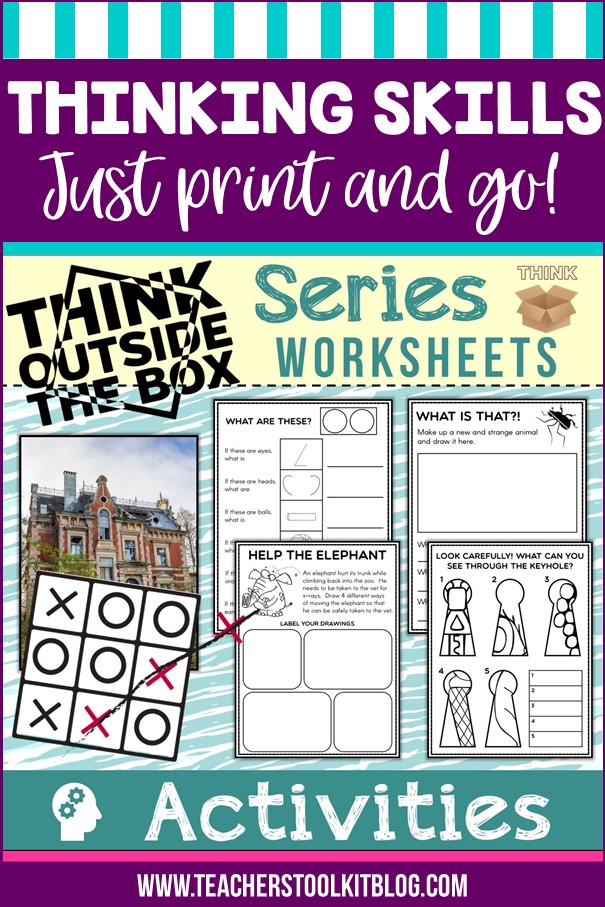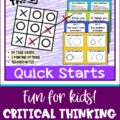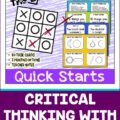Critical thinking skills are critical to our students’ success throughout their school career and beyond. The ability to make connections, solve problems, think in creative ways, and apply what they’ve learned to new situations will take their learning beyond memorization and allow them to truly internalize and interpret new information. You might also find this earlier blog post helpful.

Five tips for teaching critical thinking
1. WAIT TIME
You probably learned about wait time in one of your teaching methods courses in college. Since it seems so simple, it’s easy to overlook the value of this strategy. By giving students time to think about their answers to a question, you’re allowing the “slower” thinkers to formulate their responses. It also can help you stop calling on the same students all the time because they’re the first ones to raise their hands. To avoid those awkward pauses while you wait, you can let students know that you want to see 10 hands up before you call on someone, or that no one can raise their hands before a timer goes off (which might be set to 15 or 30 seconds).
2. SET UP A “PARKING LOT” FOR STUDENT RESPONSES
All that’s needed for this is to designate a section of wall or white board as the parking lot.
Start by asking students a critical thinking question, or giving them a problem to solve. Provide all students with sticky notes, or have small note pads with tape available. Students can write down their answers and then stick them in the parking lot. You can read the responses out loud to the class. Another option is to take down the notes and pass them out randomly to students. Then they can read them and discuss the merits of each answer.
3. WHICH SIDE ARE YOU ON?
This strategy can spark some fun and worthwhile discussions. Pose some sort of critical thinking question or problem to students, or read a statement. You can also try a somewhat controversial topic, appropriate to your grade level.
Designate different sides of the room as “AGREE” or “DISAGREE.” Ask students to decide which way they feel and then go stand on the appropriate side of the room. Lead a discussion about why students feel the way they do. Let them know they can switch sides if they change their mind during the activity.
4. QUESTION, QUESTION, QUESTION
But not just any kind of questions … they need to be open-ended questions, something that students can’t answer with a simple yes or no.
You can find many unplanned opportunities throughout the day. Be alert for situations where students can make predictions or where they might need several steps to solve a problem. “What do you think will happen next?” “Why do you think it happened this way?” “What do you think our next step should be?”
Finding out WHY students are thinking a certain way, along with helping THEM to pinpoint why, is also very helpful. By helping them discover the reasons behind their thinking, you are teaching them that there can be multiple ways to address a problem.
5. REQUIRE REFLECTION
Having students reflect on their learning and thinking will help them to discover how they learn. Use specific skills that they have been working on and ask them HOW they learned something, or when did they begin to understand a specific concept? As they think about their thinking and what works for them in learning new concepts, they can begin to plan out the best way to tackle a project or complex problem.
A reflection journal is a great way to encourage this kind of metacognition. They can also write a reflection on their learning as an exit ticket.
I’ve created a set of critical thinking activities for those times when you want to have your students working specifically on this skill.
These Critical Thinking Activities provide teachers with straightforward ideas and activities to help students develop thinking skills. In this pack you will find a wide variety of thinking challenges, which seek to develop skills in:
- fluency
- flexibility
- imaginative visualization
- creative thinking
- originality
- connecting unrelated objects
- categorizing
- questioning
Today’s students are the problem-solvers of the future. If they are taught factual knowledge only, they tend to respond with conventionally correct answers rather than exploring creative solutions. All students can learn to think critically and creatively.
Students need to be able to judge, analyze and think critically in order to participate fully in a democratic and technological society. This can be achieved if the teacher recognizes the value of thinking skills and provides opportunities for the thinking processes to be modeled and developed.
When to use:
The challenges lend themselves to various group settings. However, group work may yield the best results:
- whole group setting
- small group collaboration
- independently
These activities are all ready for you to use – just print and go!
You may also be interested in these resources:
- Surprising Shapes: Think Outside of the Box Series
- Quick Starts Task Cards: Think Outside of the Box Series
- Thinking Skills Think Outside of the Box Series: Bundle
- Logic Puzzles | Brain Teasers | Early Finishers Activities for Kindergarten
Do you have other tips for critical thinking? Please share!



